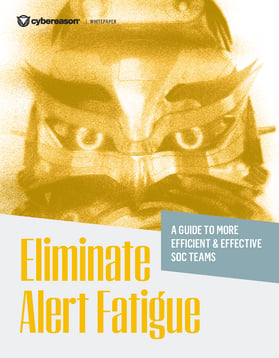
Cybereason MDR: Fast, Efficient, Effective
The MalOp Severity Score and Extended Response enable threat detection in less than 1 minute, triage in less than 5 minutes, and remediation in less than 30 minutes. ..

Dan Verton
Alert fatigue is one of the biggest challenges facing Security Operations Center (SOC) teams, worsening the already critical problem of analyst burnout and resulting in slower response times, missed threats, and increased exposure to cyber risk.
According to a recent Security Response survey, organizations employed an average of 45 security tools, all of which produce alerts when they detect an anomaly. As a result, SOC teams are forced to deal with an average of 11,000 alerts each day, nearly half of which are false positives, and 30 percent are simply ignored.
 Cybereason has tackled these challenges head-on, releasing a new white paper, Eliminate Alert Fatigue: A Guide to More Efficient & Effective SOC Teams.
Cybereason has tackled these challenges head-on, releasing a new white paper, Eliminate Alert Fatigue: A Guide to More Efficient & Effective SOC Teams.
The paper explores the challenges that create alert fatigue, the impact that alert fatigue has on security outcomes, and Cybereason's primary differentiator—the ability to consolidate alerts into a single malicious operation—what Cybereason calls a MalOp™.
Whereas other vendors alert dozens of times for a single intrusion, the Cybereason MalOp Detection Engine stitches together the separate components of an attack—including all users, devices, identities, and network connections—into a comprehensive, contextualized attack story.
Because the Cybereason Defense Platform understands the full attack story, we orchestrate and automate responses to all impacted endpoints and users through tailored response playbooks without needing an outside SOAR solution.
This advanced and automatic analysis increases analyst speed and accuracy by reducing the noise of alerts with a focused deconstruction of the overall operation. With all the information an analyst needs to scope and respond to a malicious operation concisely presented, analysts can drastically reduce their Mean Time to Respond (MTTR).
Solutions that are highly effective against today’s threats—especially sophisticated threats like ransomware—must detect malicious activity immediately without waiting for additional processing time or human analyst intervention.
Cybereason delivers 100% real-time detection by leveraging all of your data. While other solutions filter valuable event data, Cybereason uses more than 30 sources of telemetry to correlate all relevant data.
Cybereason uses artificial intelligence and machine learning to build a comprehensive picture of the attack story using all available telemetry—no "smart" filtering. When Cybereason detects malicious activity and presents that detection to an analyst, it’s a high-fidelity alert.
Moving from an alert-centric security model to an Operation-Centric model significantly improves SOC team operational effectiveness and efficiency. Small teams can do the work of larger teams, less experienced teams are immediately more effective, and your SOC’s ability to mitigate risk improves exponentially.
Improve the Efficiency & Effectiveness of Your SOC Team
Learn How
Dan Verton is Director of Content Marketing at Cybereason. Dan has 30 years of experience as a former intelligence officer and journalist. He is the 2003 first-place recipient of the Jesse H. Neal National Business Journalism Award for Best News Reporting – the nation’s highest award for tech trade journalism and is the author of the groundbreaking work, Black Ice: The Invisible Threat of Cyber-Terrorism (McGraw-Hill, 2003). He most recently served as an intelligence advisor and co-author of a nationwide TSA anti-terrorism awareness training program.
All Posts by Dan Verton
The MalOp Severity Score and Extended Response enable threat detection in less than 1 minute, triage in less than 5 minutes, and remediation in less than 30 minutes. ..

With Cybereason Managed Detection and Response (MDR), the Olist security team shortened their triage and remediation times to less than 30 minutes.

The MalOp Severity Score and Extended Response enable threat detection in less than 1 minute, triage in less than 5 minutes, and remediation in less than 30 minutes. ..

With Cybereason Managed Detection and Response (MDR), the Olist security team shortened their triage and remediation times to less than 30 minutes.
Get the latest research, expert insights, and security industry news.
Subscribe